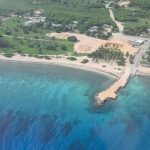End of legal turtling saved local loggerheads
(CNS): A new academic article published in the marine science magazine, Frontiers, authored by several staff members from the Department of Environment and their partners at the University of Exeter, has used 22 years of data on local turtles to demonstrate the recovery of the populations and how that can be sustained in future, given the ever-increasing threats. The study shows that a 1,000% increase in green turtle nests on Grand Cayman over that time was helped by the Turtle Farm. However, the more than 3,000% population growth in loggerheads on Little Cayman, which are not bred in captivity, began after the legal take of that species ended.
But lighting, over-development, climate change and poaching all pose continued threats to the still endangered species, according to the findings.
“We found that green (Chelonia mydas) and loggerhead (Caretta caretta) nest numbers increased significantly across the three islands since monitoring began in 1998, but that hawksbill nest numbers remained low with a maximum of 13 nests recorded in a season,” the report states. “The greatest percentage increase in green turtle nests was in Grand Cayman from 82 to 1,005 nests (1,126%), whereas the greatest percentage increase for loggerhead turtle nests was in Little Cayman from 10 to 290 nests (3,800%). A captive breeding operation contributed to the increase in the Grand Cayman green turtle population, however, loggerhead turtles were never captive-bred, and these populations began to increase after a legal traditional turtle fishery became inactive in 2008.”
The data shows both species have begun to recover but populations remain at a fragment of their historical level and are vulnerable to threats.
“Illegal harvesting occurs to this day, with multiple females taken from nesting beaches each year. For nests and hatchlings, threats include artificial lighting on nesting beaches, causing hatchlings to misorient away from the sea, and inundation of nests by seawater reducing hatch success. The impacts of lighting were found to increase over the monitoring period. Spatial data on nest distribution was used to identify critical nesting habitat for green and loggerhead turtles and is used by the Cayman Islands Department of Environment to facilitate remediation of threats related to beachside development and for targeted future management efforts.”
The report shows how important the work in Cayman is to understanding how conservationists can best support the turtles in future, and the experts conclude that “strategically targeted management efforts are needed to secure the future survival of these populations”. But assessing long-term sea turtle nesting abundance data, where trends are more easily detectable than in shorter time series, and protection efforts may take decades to prove successful.
The scientists said that efforts should be made to mitigate climate change impacts through sustainable development policies, including sufficient setback of development from the beach. Designation of critical habitat could also allow these measures to be targeted into the areas where they are needed the most.
See the full report here.
- Fascinated
- Happy
- Sad
- Angry
- Bored
- Afraid
Category: Marine Environment, Science & Nature





































All turtling should stop before there are none left.
Except the report shows that the current amount of (legal) take still allows the populations to recover. So no increase in take but no need for a ban on turtling. Just continued anti-poaching patrols (reporting by public), etc., and the turtle numbers will continue to increase.
No one needs to eat endangered animals.
No one needs to eat animals.*
Fixed it for you.
There isn’t any legal take.